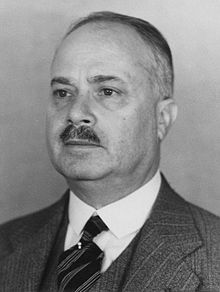Frederick C. Leonard
Frederick Charles Leonard (March 12, 1896 – June 23, 1960)
Early life
Leonard was born in Mount Vernon, Indiana in 1896 and moved with his family to Chicago in about 1900, eventually settling near the University of Chicago.[5] From the age of eight, he showed great interest in the stars and by early adolescence had become an active amateur astronomer. In 1909 he attended the annual meeting of the Astronomical and Astrophysical Society of America, held at the Yerkes Observatory. The same year, he organized the Society for Practical Astronomy (SPA),[6] a national amateur organization. Leonard's leadership raised concerns among professional astronomers[2] as not all were in favor of amateur contributions to the profession.[7][8] Nonetheless, the organization flourished until Leonard's departure in 1919.[9]
Leonard was a prolific writer and by the age of 14[10] had attracted the attention of numerous publishers.[11] He authored a year-long series of articles titled "Mr. Leonard's Star Colors" in the English Mechanic and World of Science.[11] A Chicago Tribune reporter characterized him as a "co-worker with such savants as Prof. F. R. Moulton"[11] and Francis P. Leavenworth.
After graduating from
Career
Leonard joined the University of California, Los Angeles faculty in 1922 as instructor of astronomy in the Department of Mathematics[14][15] and founded the Department of Astronomy in 1931[15] which he headed till his death in 1960.
Leonard initially focused his university research on
Throughout Leonard's career, even during times of intense research, teaching remained his primary dedication.[9] Three of "Leonard’s prize pupils" became planetarium directors later in life.[21] He was honoured by "striking a medal in his name" after his death for the contribution he had made to the development of the Meteoritical Society[14]
Kuiper belt hypothesis
Leonard was one of the first astronomers to hypothesize the existence of a trans-Neptunian population.[22] In 1930, soon after Pluto's discovery by Clyde Tombaugh, Leonard pondered whether it was "not likely that in Pluto there has come to light the first of a series of ultra-Neptunian bodies, the remaining members of which still await discovery but which are destined eventually to be detected".[22]
Personal life
Leonard married Rhoda Walton in Victoria, B. C., Canada in 1942.[23] They had two sons – Roderick and Frederick.
Death
Leonard suffered a stroke in May 1960 and died on June 23.[5]
Works
- (1935) - Bibliography of Meteorities: Second 1935 List
- (1946) – A catalog of provisional numbers for the meteoritic falls of the world
- (1956) – Catalogue of the Meteoritic Falls of the World
References
- ^ "California Death Records". The California Department of Health Services Office of Health Information and Research vital Statistics Section. 1960. Archived from the original on January 1, 2012. Retrieved January 4, 2012.
- ^ a b Sponberg, Brant L. (1999). "History of the American Astronomical Society, Amateurs in the Early AAS". American Astronomical Society. Archived from the original on April 15, 2012.
- ^ Norton, O. Richard (August 1996). "Personal Recollections of Frederick C. Leonard". Pallasite Press. Archived from the original on February 21, 2012.
- ^ "Awards of the Meteoritical Society". The Meteoritical Society. 2002. Archived from the original on August 6, 2012.
- ^ a b c "Dr. F. C. Leonard, Astronomer, Dies". New York Times. June 24, 1960. p. 27.
- .
- ISBN 978-1-56396-683-5.)
{{cite book}}: CS1 maint: multiple names: authors list (link) CS1 maint: numeric names: authors list (link - S2CID 143663297.
- ^ a b c d e California Digital Library, Frederick Charles Leonard, Astronomy: Los Angeles.
- ^ Leonard, Frederick C. (December 10, 1910). "Infinitude of the Universe". Christian Science Monitor. p. 19.
- ^ ProQuest 173552455.
- ^ University of California (System) Academic Senate; S. Herrick; G. E. F. Sherwood; D. M. Popper (April 1961). "Frederick Charles Leonard, Astronomy: Los Angeles". 1961, University of California: in Memoriam. Retrieved January 9, 2012.
- Bibcode:1921PhDT.........1L.
- ^ .
- ^ a b Stadtman, Verne A. (1967). "Astronomy". The Centennial Record of the University of California. Retrieved January 9, 2012.
- ISBN 978-0-8397-2229-8.
- .
- ISBN 978-0-87842-373-6.
- .
- ^ Norton, O. Richard (November 1996). "Personal Recollections of Frederick C. Leonard, Part II". Pallasite Press. Archived from the original on September 27, 2012.
- ^ Verish, Robert (November 2009). "O. Richard Norton (1937–2009)". Meteorite-Times Magazine. Meteorite Exchange, Inc. Archived from the original on August 27, 2010.
- ^ a b "What is improper about the term "Kuiper belt"? (or, Why name a thing after a man who didn't believe its existence?)". International Comet Quarterly. Retrieved October 24, 2010.
- ^ "Haupts Will Honor Pair". Los Angeles Times. July 31, 1942. p. A5.
Hockey, Thomas A; Bracher, Katherine (November 20, 2007),
Leonard, Frederick D. (March 1, 2018). "Frederick C. Leonard: A history and personal recollections". Meteoritics & Planetary Science. 53 (3): 359–374.

